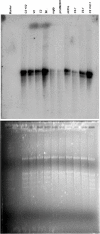Grapevine red blotch virus C2 and V2 are suppressors of post-transcriptional gene silencing
- PMID: 36967958
- PMCID: PMC10033742
- DOI: 10.1016/j.heliyon.2023.e14528
Grapevine red blotch virus C2 and V2 are suppressors of post-transcriptional gene silencing
Abstract
Grapevine red blotch virus (GRBV) is the causative agent of grapevine red blotch disease (GRBD) which is one of the major threats faced by grapevine industry in the United States. Since its initial identification in 2011, the disease has rapidly spread in the major US grape-growing regions of the Pacific Northwest, causing major economic impacts. Geminiviruses, the largest family of plant viruses, can induce and be targeted by host post-transcriptional gene-silencing (PTGS) anti-viral mechanisms. As a counter-defense mechanism, viruses have evolved viral silencing suppressor proteins to combat PTGS mechanisms and establish a successful infection in host plants. Here we provide characterization of two ORFs of GRBV, C2 and V2 as viral silencing suppressors. In Nicotiana benthamiana line 16c GFP marker plants, synergism or additive effects of C2 and V2 suppressors was observed at the mRNA level when they are expressed together transiently. Additionally, we showed there is no evidence by yeast two-hybrid of self-interaction (dimerization) of C2 or V2 proteins, and no evidence of physical interaction between these two suppressors.
Keywords: Geminivirus; Grablovirus; Grapevine red blotch virus; Post-transcriptional gene silencing; Silencing suppressors; Viral ORF.
Published by Elsevier Ltd.
Conflict of interest statement
The authors declare the following financial interests/personal relationships which may be considered as potential competing interests:The authors’ institution has filed a utility patent application with authors as inventors: “Method and compositions for engineering Grapevine Red Blotch Virus-resistant grapevine,” WO2021/119130A1 and PCT/US2020/064014 (filed September 12, 2020) drawn in part from this work.
Figures





References
-
- Fuchs M. Grapevine viruses: a multitude of diverse species with simple but overall poorly adopted management solutions in the vineyard. J. Plant Pathol. 2020;102:643–653. doi: 10.1007/s42161-020-00579-2. - DOI
-
- Al Rwahnih M., Rowhani A., Golino D. First report of grapevine red blotch-associated virus in archival grapevine material from sonoma county, California. Plant Dis. 2015;99:895. doi: 10.1094/PDIS-12-14-1252-PDN. - DOI
-
- Cieniewicz E., Perry K., Fuchs M. In: Grapevine Viruses: Molecular Biology, Diagnostics and Management. Meng Baozhong, Martelli Giovanni P., Golino Deborah A., Fuchs Marc., editors. Springer International Publishing; 2017. pp. 303–314.
LinkOut - more resources
Full Text Sources
Research Materials
Miscellaneous

